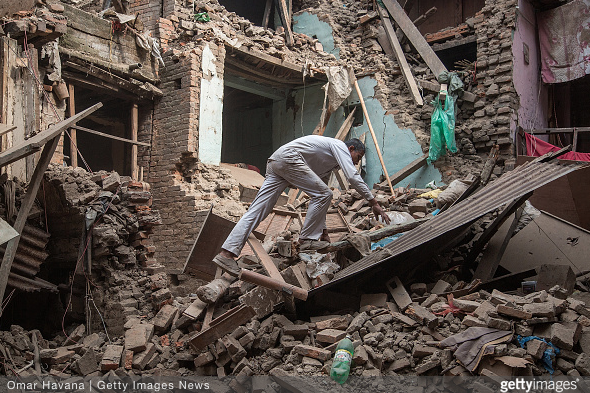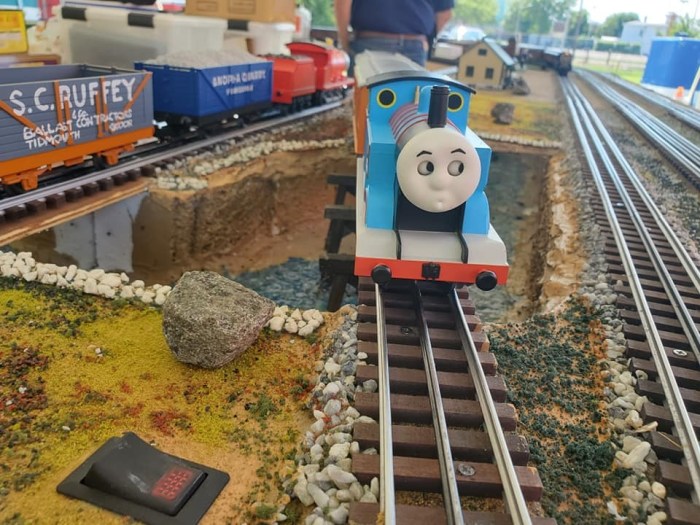The first dead body I ever saw was lying on a funeral pyre in Nepal. It wasn’t a high-caste affair at the Pashupatinath Temple in Kathmandu. There was no tell-tale shroud, so I was surprised when I realized that the oddly shaped stick being licked by the flames was actually an emaciated brown limb. Then I noticed the calloused foot.
Now there’s so much death, so much destruction, it’s all you can see. The death toll is rising into the tens of thousands as the international rescue effort struggles to reach the far-flung villages of Nepal. As the days stretch into weeks before help arrives, I hope the living won’t come to envy the dead. I’ve trekked on those steep winding trails, climbing one hill only to descend to a narrow valley, and having to cross swinging rope bridges over raging rivers that would have given Indiana Jones second thoughts.
When I spotted the top of a stupa, a Buddhist temple, overlooking a pile of rubble in Kathmandu, I felt some relief to know that some artifacts of the country’s priceless heritage survived the devastation. But so much will be lost forever.
Kathmandu had its heyday about 500 years ago, give or take a century or two, when the silk trade between China and India was very lucrative through those Himalayan passes. At one point in the Kathmandu valley there were actually three kingdoms, when the royal family split apart, each son apparently competing with the others to build the most impressive temple complex in Bhaktapur and Patan as well as in the original royal city. Those are the pagoda structures that took the biggest hit from the massive shockwave.
Until 1951, Nepal was known as “the forbidden kingdom,” a Hindu monarchy about the size of Tennessee wedged between India and Tibet, separated on the north by the Himalayas, the highest mountain range in the world culminating with Mount Everest, and on the south by the Terai, tropical lowlands where the Buddha was born in Lumbini more than two millennia ago. The country’s sovereignty was protected by a treaty between Great Britain’s East India Company and Nepal’s aristocracy, who guaranteed a supply of troops in exchange for never becoming a colony like India. It was those fierce soldiers, the Gurkhas, who made a name for themselves fighting alongside the Allies against the Japanese in World War II.
When they returned home after the war, they brought a different world view that ultimately led to a unique revolution. Instead of overthrowing the raja—the king—it restored him to power because since the 19th century the ruling family were the Ranas, whose progeny became Nepal’s hereditary prime ministers. The status quo came to an abrupt end in 1950 when King Tribhuvan Bir Bikram Shah managed to escape the Ranas’ guards by allegedly going on a hunting trip with his family but instead seeking asylum in India. Tellingly, the Nepalese regard him as the Father of the Nation because he set the country on the path to a constitutional monarchy. He died in 1955.
I arrived in Nepal in time for the 1975 coronation of his 29-year-old grandson, Birendra Bir Bikram Shah Dev, which had been delayed for a few years by the royal astrologers until the signs were most auspicious. Thanks to my college program, I’d taken my junior year abroad to live with a Nepalese family and get academic credit for making a 16 mm film and writing an article for The Rising Nepal Newspaper.
That’s how I ended up at the home of Rishikesh Shah, Nepal’s first ambassador to the United Nations. On the walls of his study were photos of him shaking hands with President John F. Kennedy and Premier Nikita Krushchev. But I never met him because he was residing out of the country while writing a book about the monarchy. Instead, my official host was his wife, a friendly, rather rotund woman, who greeted me upstairs in her bedroom, where she was seated in the middle of a large bed surrounded by paperback novels written in Newari, one of Nepal’s dozens of dialects. She was entertaining a stately, elderly gentleman who seemed to be most amused by my purpose in coming to Nepal.
What caste, he asked me, did I wish to be considered equal to? Being an uppity 22-year-old, I scoffed at the notion and told him brashly that in America we had no castes; everyone was equal in the pursuit of happiness. He turned to Mrs. Shah and they nodded at each other knowingly. And so I found myself eating my meals and hanging out with her servants. My dinners were their nightly entertainment. Sometimes, I’d eat before 10 people, all crowded into a tidy kitchen at the back of Mrs. Shah’s compound, watching me plow through mounds of rice, hot chili curries and lentils, the sweat dripping off my brow. And whenever I managed to utter something in Nepalese, which I was allegedly learning during the day, they burst into laughter and smiled broadly.
One of the highlights of my five months’ stay was seeing the raja and rani perched in their red velvet-canopied throne atop a lumbering decorated elephant as the royal procession left the old palace in Kathmandu’s Durbar Square after the coronation ceremony. Rani, also known as Queen Aiswarya, didn’t look too comfortable riding up in their howdah, no doubt preferring to be in the back seat of Rolls-Royce.
By the 1990s, Raja Birendra had his hands full. But the worst was yet to come. In June 2001, he and seven members of his family were murdered by his own son and heir apparent, Crown Prince Dipendra, in the new palace. Apparently, the raja, regarded as the reincarnation of Lord Vishnu, the Preserver, was no match for the barrage of bullets fired by his 29-year-old son who may have become unhinged because he’d fallen in love with a woman his mother disapproved of—and the astrologers had advised postponing his marriage until he was 35.
The Maoist rebels put their guns down in 2006 but the Nepal government has never gained ground, let alone the upper hand. The average annual income is pegged at $700 a year, and that’s generous. One of the highest-paid gigs is also one of the most dangerous, being a Sherpa guide up Mount Everest where the pay might be up to $5,000. When the recent earthquake struck, it triggered a deadly avalanche that leveled the base camp at 18,000 feet above sea level, killing at least 18 people, injuring and stranding dozens more.
The same geological force propelling Mount Everest to become the summit of mountaineers’ aspirations—the tectonic collision slamming the Indian and Eurasian plates—has torn the land asunder. It was only a matter of time.
Today these irreplaceable structures lie in ruins.
The question now is not about replacing the past, but helping the Nepalese survive the present.





























